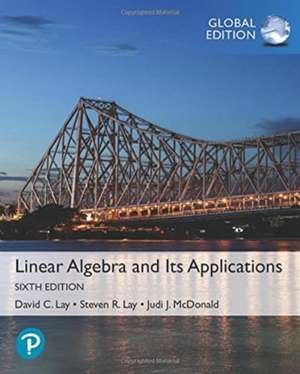Linear Algebra and Its Applications, Global Edition
Autor David Lay, Judi McDonald, Steven Layen Limba Engleză Paperback – 4 feb 2021
Preț: 522.34 lei
Preț vechi: 600.39 lei
-13% Nou
Puncte Express: 784
Preț estimativ în valută:
99.95€ • 104.84$ • 83.21£
99.95€ • 104.84$ • 83.21£
Carte disponibilă
Livrare economică 11-25 martie
Livrare express 25 februarie-01 martie pentru 56.79 lei
Preluare comenzi: 021 569.72.76
Specificații
ISBN-13: 9781292351216
ISBN-10: 1292351217
Pagini: 672
Dimensiuni: 207 x 255 x 32 mm
Greutate: 1.26 kg
Ediția:6 ed
Editura: Pearson Education
ISBN-10: 1292351217
Pagini: 672
Dimensiuni: 207 x 255 x 32 mm
Greutate: 1.26 kg
Ediția:6 ed
Editura: Pearson Education
Notă biografică
David C. Lay, University of Maryland-College Park
Steven R. Lay, Lee University
Judi J. McDonald, Washington State University
Steven R. Lay, Lee University
Judi J. McDonald, Washington State University
Cuprins
About the Authors Preface A Note to StudentsChapter 1 Linear Equations in LinearAlgebra
- Introductory Example: Linear Models in Economics and Engineering
- 1.1 Systems of Linear Equations
- 1.2 Row Reduction and Echelon Forms
- 1.3 Vector Equations
- 1.4 The Matrix Equation Ax= b
- 1.5 Solution Sets of Linear Systems
- 1.6 Applications of Linear Systems
- 1.7 Linear Independence
- 1.8 Introduction to Linear Transformations
- 1.9 The Matrix of a Linear Transformation
- 1.10 Linear Models in Business,Science, and Engineering
- Projects
- Supplementary Exercises
- Introductory Example: Computer Models in Aircraft Design
- 2.1 Matrix Operations
- 2.2 The Inverse of a Matrix
- 2.3 Characterizations of Invertible Matrices
- 2.4 Partitioned Matrices
- 2.5 Matrix Factorizations
- 2.6 The Leontief InputOutput Model
- 2.7 Applications to Computer Graphics
- 2.8 Subspaces of n
- 2.9 Dimension and Rank
- Projects
- Supplementary Exercises
- Introductory Example: Random Paths and Distortion
- 3.1 Introduction to Determinants
- 3.2 Properties of Determinants
- 3.3 Cramer's Rule, Volume, and Linear Transformations
- Projects
- Supplementary Exercises
- Introductory Example: Space Flightand Control Systems
- 4.1 Vector Spaces and Subspaces
- 4.2 Null Spaces, Column Spaces,and Linear Transformations
- 4.3 Linearly Independent Sets; Bases
- 4.4 Coordinate Systems
- 4.5 The Dimension of a Vector Space
- 4.6 Change of Basis
- 4.7 Digital Signal Processing
- 4.8 Applications to Difference Equations
- Projects
- Supplementary Exercises
- Introductory Example: Dynamical Systems and Spotted Owls
- 5.1 Eigenvectors and Eigenvalues
- 5.2 The Characteristic Equation
- 5.3 Diagonalization
- 5.4 Eigenvectors and Linear Transformations
- 5.5 Complex Eigenvalues
- 5.6 Discrete Dynamical Systems
- 5.7 Applications to Differential Equations
- 5.8 Iterative Estimates for Eigenvalues
- 5.9 Markov Chains
- Projects
- Supplementary Exercises
- Introductory Example: Artificial Intelligence and Machine Learning
- 6.1 Inner Product, Length, and Orthogonality
- 6.2 Orthogonal Sets
- 6.3 Orthogonal Projections
- 6.4 The GramSchmidt Process
- 6.5 Least-Squares Problems
- 6.6 Machine Learning and LinearModels
- 6.7 Inner Product Spaces
- 6.8 Applications of Inner Product Spaces
- Projects
- Supplementary Exercises
- Introductory Example: Multichannel Image Processing
- 7.1 Diagonalization of Symmetric Matrices
- 7.2 Quadratic Forms
- 7.3 Constrained Optimization
- 7.4 The Singular Value Decomposition
- 7.5 Applications to ImageProcessing and Statistics
- Projects
- Supplementary Exercises
- Introductory Example: The Platonic Solids
- 8.1 Affine Combinations
- 8.2 Affine Independence
- 8.3 Convex Combinations
- 8.4 Hyperplanes
- 8.5 Polytopes
- 8.6 Curves and Surfaces
- Projects
- Supplementary Exercises
- Introductory Example: The Berlin Airlift
- 9.1 Matrix Games
- 9.2 Linear ProgrammingGeometric Method
- 9.3 Linear ProgrammingSimplex Method
- 9.4 Duality
- Projects
- Supplementary Exercises
- Introductory Example: Googling Markov Chains
- 10.1 Introduction and Examples
- 10.2 The Steady-State Vector andGoogle's PageRank
- 10.3 Communication Classes
- 10.4 Classification of States andPeriodicity
- 10.5 The Fundamental Matrix
- 10.6 Markov Chains and BaseballStatistics
- Uniqueness of the Reduced Echelon Form
- Complex Numbers Credits Glossary Answers to Odd-Numbered Exercises Index
